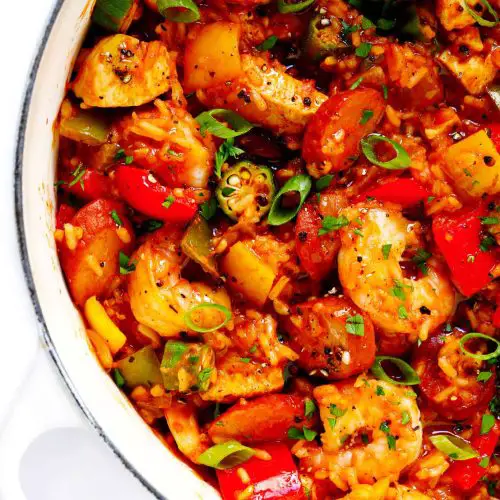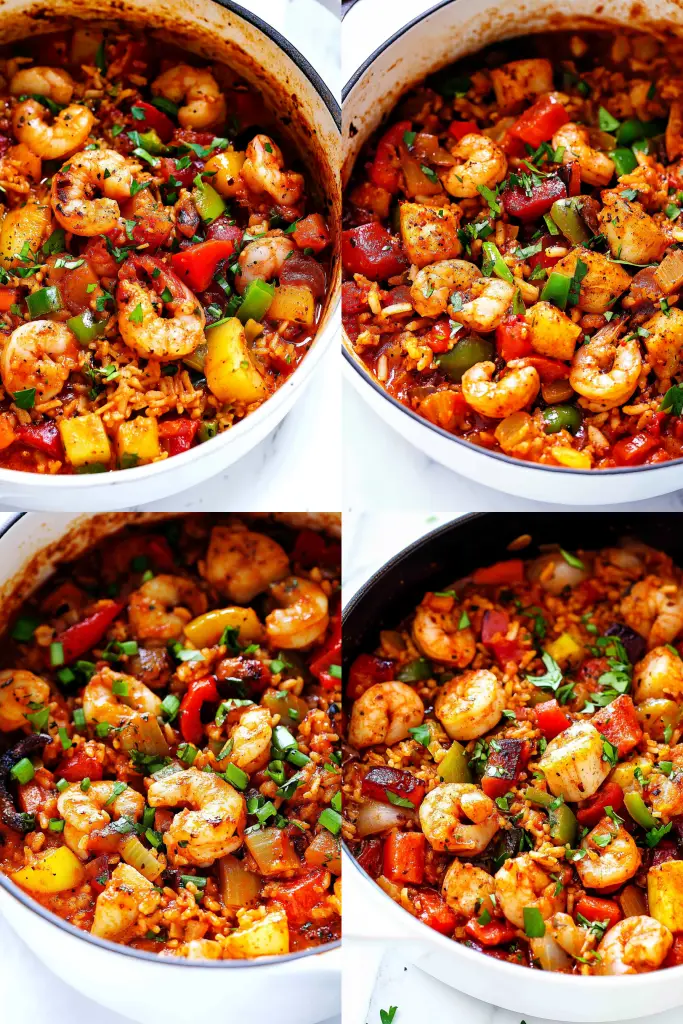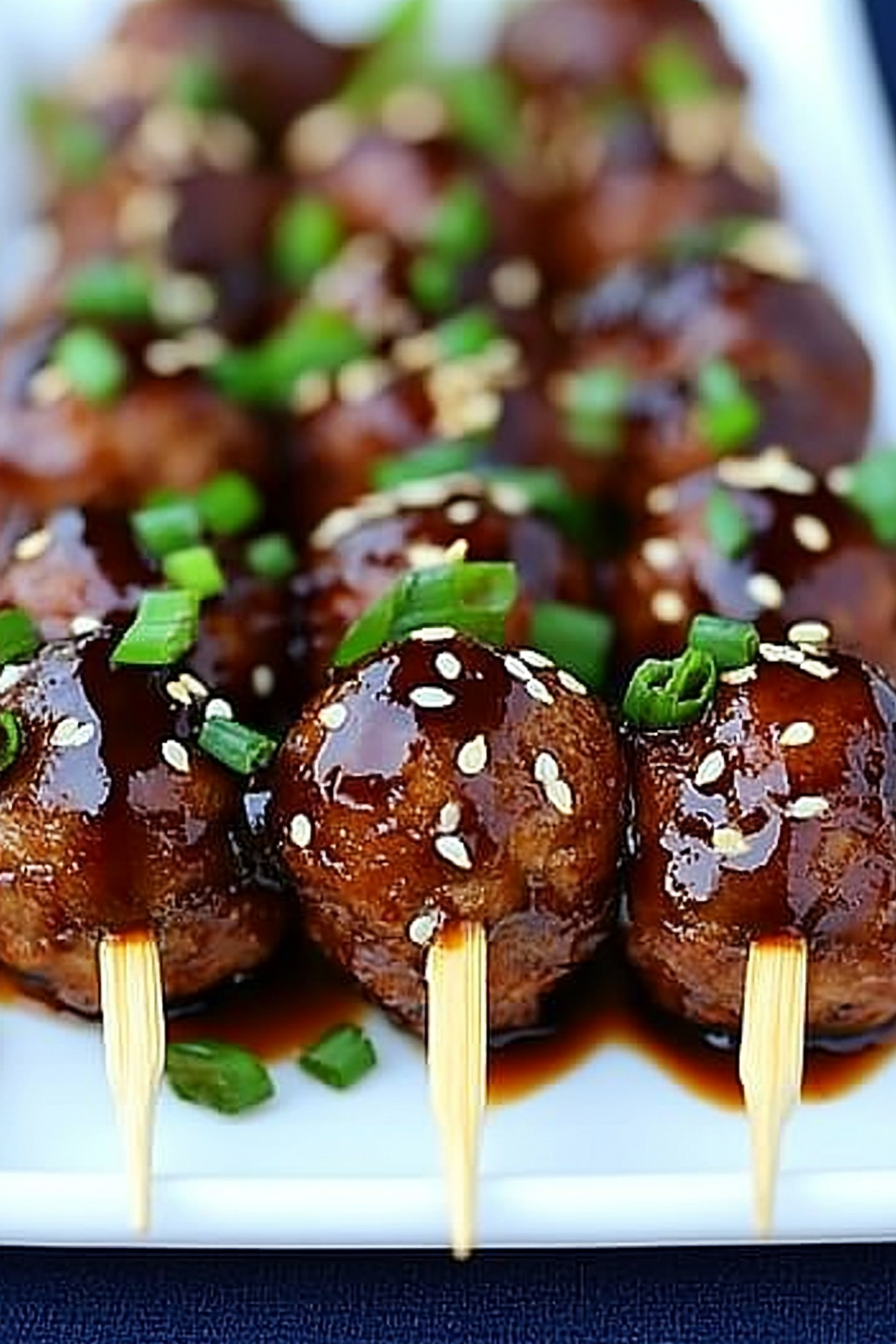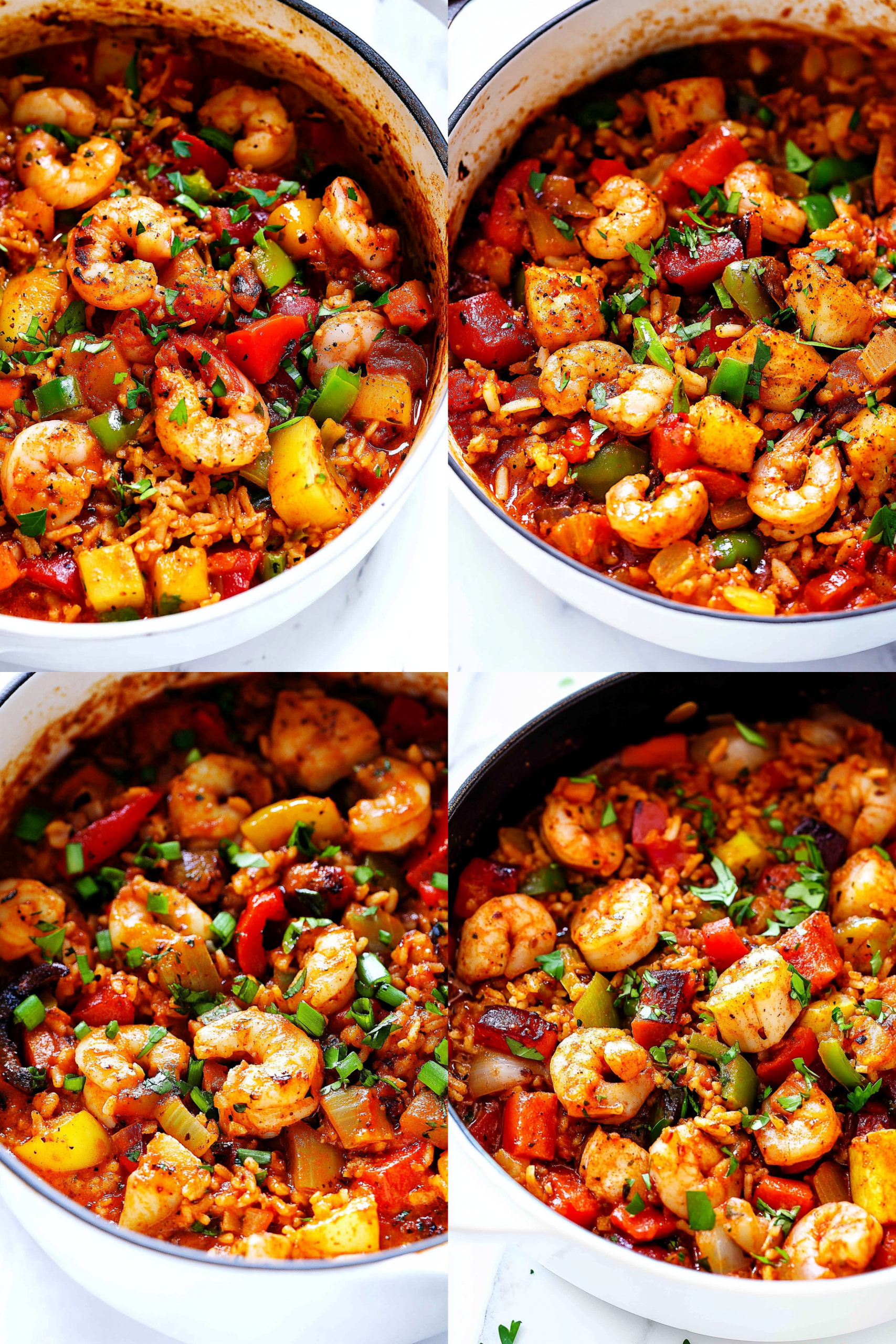There’s something about a bubbling pot of jambalaya that smells like family, late-summer evenings, and a hallway full of chatter. I still remember Grandma’s cast-iron stew pot simmering away on the stove, the peppers turning sweet and glossy as the rice took on a velvet shine. This jambalaya recipe is a little like a warm hug in a bowl—simple enough for a weeknight, yet bold enough to feel celebratory on a weekend finisher. It’s the kind of dish that tastes like you’ve been cooking all day, even when you pulled it together in under an hour. I compare it to a more familiar skillet of paella in the way it celebrates rice, stock, and a chorus line of meat and vegetables, but this one stays unapologetically Cajun—bright, soulful, and deeply comforting. The aroma alone brings everyone to the kitchen, and my kids actually ask for seconds before I’ve plated the first serving. This is the Jambalaya recipe I reach for when I want warmth, heartiness, and a little kick in every bite.
What is Jambalaya?
Think of a big pot where rice plays center stage, soaked up by a smoky, peppery broth and a lively mix of meats. Jambalaya is essentially a one-pot celebration of textures and flavors: browned sausage, tender chicken or shrimp, bell peppers, celery, onions, garlic, and tomatoes all mingling with paprika, cayenne, and thyme. The name’s origins are a topic of lively debate—some say it’s Cajun, some say Creole—but the spirit is the same: a sturdy, comforting dish that loves to be shared. This Jambalaya recipe leans into accessibility: you can swap proteins to fit what’s in the fridge, and the spice level embraces your personal heat tolerance. It’s basically a timeless kitchen hack—bold, doable, and wildly satisfying—perfect for feeding a crowd or packing for next-day lunches. Think of it as a fragrant, make-ahead-friendly method that still feels like a home-cooked hug.
Why you’ll love this recipe?
What I love about this Jambalaya
- Flavor: A smoky, tomato-forward, peppery profile with notes of garlic and herbs. The sausage adds a savory richness, while the chicken or shrimp contributes juicy contrast. The long simmer pulls everything into a cohesive, comforting sweetness that lingers on the palate.
- Simplicity: This is a one-pot dinner from start to finish. You brown, you simmer, you stir, you taste—no juggling a dozen pans. It’s the kind of recipe that forgives a busy night and still tastes like you planned it for hours.
- Cost-efficiency: What is the best With affordable sausage, chicken thighs, and pantry staples, you get big flavor without breaking the bank. A little goes a long way when you layer spices and use stock as your backbone.
- Versatility: Swap proteins, tweak the heat, add shrimp, chicken, and even okra if you’ve got it. Leftovers taste even better—the rice absorbs extra seasoning and turns into a cozy midnight snack or next-day lunch.
- Family-friendly nostalgia: This dish carries memories of gatherings around a steaming pot, where everyone waited for the spoon to reach the bottom and the last bite to vanish.
What’s more, this Jambalaya recipe adapts to your pantry. I’ve learned to lighten it with turkey sausage or boost it with a splash of hot sauce right at the finish. The smell alone—roasted pepper, hammy smoke, and cumin-warmed rice—always makes me think of family meals that felt like a party, even on a Tuesday.
How to Make Jambalaya recipe
Quick Overview
This is a classic, no-nuss-awful step-by-step process: you brown the meat for deep flavor, sauté aromatic vegetables, toast the spices to wake them up, then fold in rice and stock so everything cooks together in one pot. The key is layering flavor in stages and letting the rice gently absorb the savory broth. It’s comforting, adaptable, and remarkably forgiving; if you spill a little extra stock or miss a minute on the timer, you’ll still end up with a pot that tastes homey and complete. In less than an hour, you’ll be scooping vibrant, ruby-bright rice that carries the soul of Louisiana right to your table.
Ingredients
For the Main Component:
- 2 cups long-grain white rice, rinsed and drained
- 4 cups chicken stock or low-sodium stock (adjust to rice type)
- 1 lb smoked sausage (andouille or kielbasa work well), sliced
- 1 lb boneless, skinless chicken thighs, cut into bite-sized pieces
- 1 large yellow onion, finely chopped
- 1 green bell pepper, diced
- 2 celery stalks, diced
- 4 cloves garlic, minced
- 14 oz can crushed tomatoes or tomato sauce
- 1–2 tsp Cajun or Creole seasoning, plus more to taste
- 2 bay leaves
- Salt and black pepper to taste
For the Filling:
- 2 tbsp olive oil or avocado oil
- Additional herbs to finish: parsley or green onions, chopped
- Optional: shrimp, okra, or mushrooms for extra texture
For the Glaze:
- Fresh lemon juice (a squeeze at the finish)
- Hot sauce or a drizzle of spicy oil (to taste)
- Chopped fresh parsley for a bright, green finish
Step-by-Step Instructions
Step 1: Preheat & Prep Pan
Set a wide, heavy pot or Dutch oven over medium-high heat. You want a nice browning on the sausage and chicken, not steaming them. Add a splash of oil and let it shimmer. When you hear that sizzle, you’re ready to go. The Jambalaya recipe comes alive when the meat gets caramelized edges—those brown bits become the base of flavor that later infuses the rice.
Step 2: Mix Dry Ingredients
In a small bowl, combine the Cajun or Creole seasoning with a pinch of salt and pepper. This step is all about building flavor depth before any liquid hits the pot. You’re not salting the rice yet; you’re waking up the spices so they perfume the fat and meat as soon as they touch the pan.
Step 3: Mix Wet Ingredients
Pour the crushed tomatoes into a separate bowl and measure your stock. If you like a brighter hue, you can add a teaspoon of tomato paste to deepen color and richness. The wet mix is where the pot will drink its liquid later, so you want a good balance of acidity and sweetness here.
Step 4: Combine
First, brown the sausage on one side, then flip and brown the chicken pieces. Remove them to a plate. In the same pot, add a little more oil if needed and sauté the onion, pepper, and celery until they’re tender and glossy. Stir in the garlic and let it perfume the pan for about 30 seconds. Return the meat to the pot, add the tomatoes, stock, bay leaves, and the Cajun seasoning mix. Bring to a gentle boil, then reduce to a lively simmer.
Step 5: Prepare Filling
Let the filling flavors mingle for about 10 minutes, then stir in the rinsed rice. The idea is to let the rice start soaking up all that garlicky, peppery liquid without sticking to the bottom. If you’re adding shrimp or okra, toss them in during the last 8–10 minutes of cooking so they stay tender and bright instead of turning mushy or rubbery.
Step 6: Layer & Swirl
Give the pot a gentle swirl to distribute rice evenly. Avoid vigorous stirring here—the goal is to let the rice simmer in a steady, flavorful bath. If you notice the liquid is too thick, splash in a bit more stock or water; if it’s too loose, uncover and let the pot reduce a few minutes longer. The color should be a rich, rick-red with little flecks of green from the pepper and onion.
Step 7: Bake
If you want to give this Jambalaya recipe a hands-off finish, you can slide the pot, tightly covered, into a 350°F (175°C) oven for 15–20 minutes. This helps the rice finish evenly and lets the flavors harmonize beyond the stovetop. Not everyone bakes jambalaya, but the oven method is a lifesaver on busy nights when you want the pot to do the work while you take a breath.
Step 8: Cool & Glaze
When you pull the pot from the heat, let it rest for 5–10 minutes. This is the moment the rice loosens and becomes wonderfully fluffy. Squeeze a little lemon juice over the top, scatter chopped parsley, and drizzle a touch of hot sauce if you like it with a kick. That glaze of citrus and herbs brightens the dish and makes the final plate sing.
Step 9: Slice & Serve
Because this dish isn’t a cake or a loaf, you don’t slice it. You scoop. Use a wide, flat spoon to lift a generous portion of rice with his or her preferred proteins and veggies. Serve hot, with extra lemon wedges and a simple green salad on the side. The meat is tender, the rice is tender-crisp, and the sauce clings to every grain, making each bite feel like a hug.
What to Serve It With
This Jambalaya recipe stands well on its own, but a few accompaniments elevate the experience for different occasions:
For Breakfast: A robust coffee, flaky biscuits, and a small side of peppery hot sauce to start the day with warmth. The spice level can handle a morning lift without feeling heavy.
For Brunch: A bright cucumber-mint agua fresca or a sparkling lemonade, with a side of cornbread or crisped hash browns to add texture and sweetness. The colors in a jambalaya-brunch plate are just as inviting as the flavors.
As Dessert: Jambalaya isn’t a dessert, but a small fruit-forward finale like pineapple salsa or a maple-lime yogurt can be a playful palate cleanser if you’re serving a long table of dishes.
For Cozy Snacks: Leftover jambalaya makes a fantastic base for quick stuffed peppers or a savory stuffed baked potato topping—weeknight comfort in two bites.
Personally, I love pairing it with a simple, lightly dressed greens salad and a crusty loaf for tearing off big bites. The contrast between bright greens and the smoky rice feels like a well-balanced meal in one pot, something I’ve relied on when friends drop by unannounced and we end up lingering at the table well past dessert.
Top Tips for Perfecting Your Jambalaya recipe
These little refinements have saved me more than once when a pot isn’t cooperating or I want to push the flavor just a touch further. Think of them as friendly nudges toward a restaurant-worthy finish in your own kitchen.
Rice Prep: Use a rice that holds up to simmering, like long-grain white or parboiled rice. Rinse to remove surface starch, which helps prevent a mushy texture. If you’re using brown rice, plan for extra liquid and a longer simmer time. The goal is separate grains that still soak up the sauce beautifully.
Mixing Advice: Avoid constant stirring once the rice is in. Gentle stirring is enough to keep everything moving and prevent sticking. This keeps the rice from becoming gluey and preserves a nice bite.
Spice Balance: Start with the recommended amount of Cajun seasoning and taste toward the end. If you like heat, add a little more at the finish rather than at the start, so the spice doesn’t dull during cooking.
Ingredient Swaps: I’ve swapped turkey sausage for a milder version, added shrimp at the end, and even tossed in a handful of okra for extra texture. For a vegetarian version, you can substitute mushrooms and tofu, but the depth will shift—plan a longer simmer and a bit more stock.
Baking Tips: If you bake the jambalaya, keep the lid on so the steam condenses back into the pot. Check for doneness after 15 minutes and adjust, because ovens vary. A gentle bake helps the flavors mingle and the rice finish evenly without scorching the bottom.
Glaze Variations: A quick finish of lemon juice, chopped parsley, and a dash of hot sauce is my go-to. If you want something sweeter, a tiny drizzle of maple syrup with lime zest can add a surprising pop that still stays balanced with the spice.
Lessons learned: don’t skip the browning—those fond bits are flavor gold. I also learned to taste the broth before adding all the rice; it should taste almost finished so you’re not chasing salt once the starch swells. My go-to trick is to season in layers: a light sprinkle at the start, a pinch after the rice goes in, and a final taste before serving. It’s not fancy, but it works every time and lets you adjust with confidence.
Storing and Reheating Tips
Leftover jambalaya is a treasure when you’re short on time, but it does better with a few care steps. Here’s how I keep it fresh and flavorful.
Room Temperature: If you’re serving within a couple of hours, keep it covered and off the heat to maintain moisture. Don’t leave cooked rice at room temperature for more than two hours to avoid safety risks.
Refrigerator Storage: Store in an airtight container for up to 3 days. Reheat gently on the stove with a splash of stock or water to loosen the rice and bring back the aroma.
Freezer Instructions: Jambalaya freezes beautifully if stored in sturdy freezer-safe containers or heavy-duty bags. It will keep for up to 2–3 months. Thaw overnight in the fridge, then reheat on the stove or in a covered dish in the oven with a little extra stock.
Glaze Timing Advice: If you’re planning to freeze, wait to add lemon and herbs until you reheat so you keep brightness intact. If you’re serving within a day or two, you can finish with a fresh squeeze of lemon and herbs just before plating for a zingy finish.
In practice, this dish shines best when you reheat gently and let the flavors rejoin. I’ve found that a quick stir and a splash of stock or water restore the texture and mouthfeel almost like you just cooked it.
Frequently Asked Questions
Final Thoughts
If you’ve ever wished for a dinner that feels like a cozy family gathering but comes together in a single pot, this Jambalaya recipe is for you. The beauty lies in its adaptability—the way it welcomes what’s in your fridge and handles a little improvisation with grace. It’s a dish that travels from weeknights to weekend company with ease, and the scent alone has a way of drawing people to the table. I’ve tested this exact method countless times, tweaking the spice balance and timing, and it never fails to deliver warmth and comfort. So, gather your ingredients, invite a neighbor if you like, and let the pot do the talking. And please, tell me in the comments how you like to customize it—your version might become our next family favorite. Happy cooking, friends, and may your spoon always find the right bite.

Jambalaya recipe
Ingredients
Main Ingredients
- 0.5 pound smoked sausage sliced
- 1 pound shrimp peeled and deveined
- 0.5 pound chicken breast diced
- 1 large onion chopped
- 0.5 cup bell pepper chopped (any color)
- 2 cloves garlic minced
- 1 can diced tomatoes undrained, 14.5 ounce
- 4 cup chicken broth
- 1.5 cup white rice
- 0.5 teaspoon cayenne pepper
- 1 teaspoon dried thyme
- 0.5 teaspoon paprika
- 0.5 teaspoon salt
- 0.25 teaspoon black pepper
Instructions
Preparation Steps
- In a large pot or Dutch oven, cook the smoked sausage over medium-high heat until browned. Remove sausage and set aside, leaving drippings in the pot.
- Add the diced chicken to the pot and cook until browned on all sides. Remove chicken and set aside.
- Add the chopped onion and bell pepper to the pot and cook until softened, about 5-7 minutes.
- Stir in the minced garlic and cook for 1 minute more until fragrant.
- Add the undrained diced tomatoes, chicken broth, cooked sausage, cooked chicken, rice, cayenne pepper, dried thyme, paprika, salt, and black pepper to the pot. Stir to combine.
- Bring the mixture to a boil, then reduce heat to low, cover, and simmer for 20-25 minutes, or until the rice is cooked and liquid is absorbed.
- Stir in the shrimp and cook for an additional 5 minutes, or until the shrimp are pink and cooked through.
- Taste and adjust seasonings as needed. Serve hot.
Notes
Featured Comments
“Impressed! Clear steps and comforting results. Perfect for busy nights.”
“New favorite here — turned out amazing. crowd-pleaser was spot on.”
“Super easy and turned out amazing! My family asked for seconds. Saving this one.”
“This sweet treat was absolutely loved — the light really stands out. Thanks!”
“Made it tonight and wow — so flavorful! Will definitely make Jambalaya recipe again.”
“Packed with flavor and so simple. Exactly what I wanted from Jambalaya recipe.”












